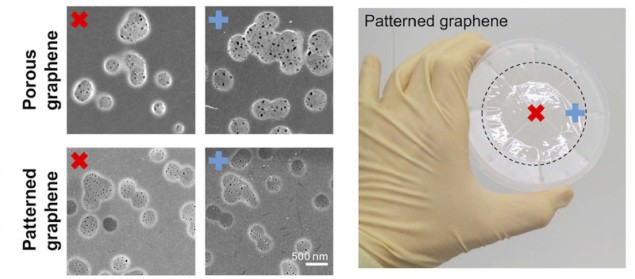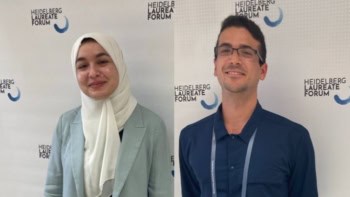
Perforated graphene membranes could be used in next-generation filtration and gas separation applications because they can efficiently and quickly filter liquids and gases. A team of researchers in Switzerland and Korea has now developed two new processes to make such membranes with sub-100 nm pores. The structures are not only simpler and more permeable than those developed previously but they can also be scaled for industry – something that has been a challenge so far. The membranes might be used to remove bacteria and viruses from drinking water, in biomedical filtration applications, wearable electronics platforms and breathable fabric.
Graphene is a sheet of carbon just one atom thick, first isolated in 2004. Ever since then, researchers have been looking to use the material as a filter by perforating it with nanometre size holes.
Two bottom-up and top-down techniques are complementary
The highly porous perforated graphene produced by Hyung Gyu Park and colleagues of ETH Zurich and Pohang University of Science and Technology (POSTECH) could be suitable for ultrafiltration and as a 2D scaffold for making ultrathin gas-selective polymers. The two bottom-up and top-down techniques developed by the researchers are complementary and allow them to make perforated membranes comprising a predefined number of graphene layers.
“Our top-down method combines block-copolymer nanolithography and anisotropic plasma etching of double-layer graphene and allows for scaled-up perforation in a relatively cost-effective way,” explains Park. We have spent many years trying to obtain a large-scale uniform pore pattern using self-assembled block-copolymers made from polystyrene (PS) and polymethylmethacrylate (PMMA) by allowing few-tens-of-nanometre-wide PMMA spheres to form within a PS matrix. After chemically stripping the PMMA spheres away, we obtain a large-scale uniform pore pattern in the PS matrix.”
Fast and cost-effective manufacturing method
The researchers say that they can puncture the entire graphene sheet with nanometre-sized holes by bombarding ion plasma through the porous PS-matrix. “The spherical block-copolymers allow for large-scale patterning while the single-step plasma etching of the pores makes this manufacturing method fast and cost-effective,” explains team member Roman Wyss.
The bottom-up method is different in that it creates pores in graphene when it is actually being synthesized. “Here, we allow catalytically inactive nanoparticles to spread over a copper catalyst layer before the chemical vapour deposition step in which graphene is manufactured,” adds team member Kyoungjun Choi. “By controlling the size of the inactive nanoparticles, we can easily obtain porous graphene.”
The two techniques, which are described in Science Advances DOI: 10.1126/sciadv.aau0476, produce samples up to 25 cm2 in size in which the pore size is uniform and controllable in the sub-20 nm to 50 nm range on average. The researchers tested their membranes by measuring the flow of nitrogen gas and liquid water through them.
Ultrafiltration membranes
“The structures we analysed have high permeances for liquids of up to 5.55 x 10-8 m3/s/Pa combined with good filtration/separation performance,” Park tells Physics World. “They might be used as ultrafiltration membranes able to remove, for example, bacteria and viruses from drinking water.”
Biomedical filtration, wearable electronics platforms and breathable fabrics may also be potential application areas. Indeed, the researchers, who are funded by the Swiss government, say they are now working with a Swiss start-up company, HeiQ Materials AG to develop a breathable textile that repels liquids while being permeable to gases.
“We are now exploring these various filtration applications and are also working on better understanding the mechanisms behind liquid and gas transport in these membranes,” says Park.



